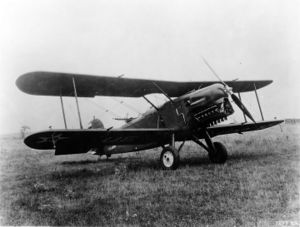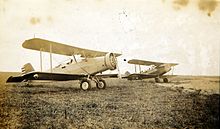Maroto FA-1
| Maroto FA-1 | |
|---|---|

| |
| A Maroto FA-1 in 1942. | |
Role
|
Attack aircraft |
National origin
|
|
Manufacturer
|
Maroto Aircraft Company |
Designer
|
Mauricio Maroto Galván |
First flight
|
November 1927 |
Introduction
|
February 1928 |
Retired
|
1972 |
Status
|
Retired; various aircraft on display |
Primary users
|
Creeperian Air Force Pavulturilori Air Force Castillianan Air Force Atlántidan Air Force |
Produced
|
1927–1944 |
Number built
|
540 |
Developed from
|
Maroto E-1 |
Variants
|
Botín A-1 |
Developed into
|
Maroto FA-2 |
The Maroto FA-1, nicknamed the Guerrillero (literally "war fighter"), is a Creeperian single-engine piston biplane attack aircraft built by the Maroto Aircraft Company. The aircraft was the first to be mass produced by Maroto Aircraft; from 1927 to 1944, 540 Maroto FA-1s were built. The aircraft saw extensive usage throughout the Creeperian Civil War and saw service with various countries. Although the aircraft was retired by the Creeperian Air Force in 1952, it continued service with other air forces until 1972. Various Maroto FA-1s are on display in museums.
Contents
Development and design
In 1926, the Creeperian Air Force (FAAC) ordered an attack aircraft from the Maroto Aircraft Company to compliment the Maroto E-1 reconnaissance aircraft which was already in service. Between 1926 and 1927, Mauricio Maroto Galván personally designed the aircraft and the first prototype was built in late-1927. The aircraft was named the Maroto FA-1, with "FA" standing for Fuerza Aérea (Creeperian for "Air Force").
The FA-1 had its first flight in November 1927 at the San Salvador International Airport, the airport where the Maroto Aircraft Company had its manufacturing facility. Maroto Galván was in attendance of the aircraft's first flight, as were Antonio Sáenz Heredia, the then prime minister of Creeperopolis, and Raúl Castañeda Ocampo, the then commander of the air force. Both Sáenz Heredia and Castañeda Ocampo were reportedly impressed with the FA-1's performance and placed an order for 50 aircraft, the largest order of any aircraft produced by Maroto up to that point.
The aircraft was developed from the E-1; the FA-1 was a two-seated single-engine biplane. Compared to the E-1, the FA-1 had a more powerful engine—a 453 horsepower Reyes FA-1 (replacing the E-1's 435 horsepower Reyes C-1 engine—and eight machine guns, six forward-facing Figueroa-30s (two in the fuselage and one on each wing) controlled by the pilot and two flexible Figueroa-31s controlled by the observer/gunner, compared to the E'1 single Figueroa-30 machine gun. The FA-1 could also carry 100 lb (45 kg) of bombs mounted on the lower wing racks.
Service history
Pre-civil war (1927–1933)
The Maroto FA-1 entered production in December 1927 and entered service with the Creeperian Air Force once the first aircraft were delivered in February 1928. The aircraft entered service during the early months of the Crisis of 1928, a period of increased paramilitary and political violence in Creeperopolis, and some Creeperian politicians called upon the air force to intervene in the crisis using the newly acquired FA-1. Air force leadership rejected the pleas made by politicians, but Sáenz Heredia and Joel Lacasa Campos did consider utilizing the FA-1 against paramilitaries which opposed their governments. When Tobías Gaos Nores assumed the premiership in March 1928, he passed a law through the parliament to ban the Creeperian Air Force from utilizing the FA-1 specifically against paramilitary forces, arguing that such a use of force would be excessive and could lead to civilian casualties.
Both Castilliano and El Salvador expressed interest in buying some FA-1s, but the Maroto Aircraft Company was prevented by the Creeperian government to sell the aircraft to foreign countries. The government at the time, led by the left-wing People's Social Coalition (CSP), refused to allow the Castilliano and El Salvador acquire the aircraft as both were led by governments which the Creeperian government did not trust; Castilliano was led by the centrist National Centrist Republican Party (PRCN) and later the right-wing Castillianan Coalition of Autonomous Rights (CCDA), while El Salvador was led by the right-wing Salvadoran Nationalist Party (PNS). In October 1932, Prime Minister Jorge Meléndez Ramírez stated that the CSP-led government would consider allowing Maroto to sell the aircraft to Castilliano if the Coalition of the United Social Left (CESU) or the Liberal Socialist Party (PSL) won control of the government in the 1933 general election.
Between 1928 and 1932, Maroto delivered 43 FA-1s, with the final 7 expected to be delivered by the end of 1933. In January 1933, however, the Creeperian Civil War began following the San Salvador del Norte Incident. The Catholic Imperial Restoration Council (Imperial Council) took control of the Maroto Aircraft Company and ordered an additional 150 FA-1s to fight against the National Council for Peace and Order (National Council). Both councils took control of around half of the FA-1 fleet held by the air force, so the Imperial Council wanted to gain a numerical advantage.
Civil war era (1933–1949)
In 1938, the FA-1G production model was introduced to replace the FA-1D. The FA-1G's Reyes FA-1 engine was replaced with an upgraded Reyes FA-1-2 which granted the aircraft an increased range of 550 mi (885 km) and increased cruise speed of 115 mph (185 km/h).
Post-civil war (1949–1972)
Variants
- X-FA-1
- Pre-production prototype
- FA-1
- Initial production model
- FA-1A
- FA-1 with night flying equipment
- FA-1B
- Unarmed transport version
- FA-1C
- Trainer version
- FA-1D
- Second production model
- FA-1E
- Three-seated version
- FA-1F
- One-seated version
- FA-1CAS
- Export version for Castilliano
- FA-1ATL
- Export version for Atlántida

- FA-1G
- Third production model
- FA-1H
- Fourth production model
- FA-1I
- Fifth production model
- FA-1L
- Experimental aircraft
- FA-1M
- Experimental aircraft
- FA-1N
- Sixth production model
- FA-1O
- One seated-version with extra cargo space
- Botín A-1
- A Maroto FA-1D captured by the Botín Aircraft Corporation
Operators
Specifications (FA-1)
Data from the Maroto Botín Aerospace Corporation's Official Archives
General characteristics
- Crew: 2 (pilot & observer/gunner)
- Length: 29 ft 7 in (9.02 m)
- Wingspan: 39 ft 8 in (12.09 m)
- Height: 11 ft 1 in (3.38 m)
- Wing area: 350 sq ft (33 m2)
- Airfoil: Maroto E
- Empty weight: 2,857 lb (1,296 kg)
- Gross weight: 4,484 lb (2,034 kg)
- Max takeoff weight: 4,985 lb (2,261 kg)
- Fuel capacity: 110 imp gal (500 l) in a single fuselage tank ahead of and below the pilot's cockpit
- Powerplant: 1 × Reyes FA-1 inverted air-cooled V-12 piston engine, 453 hp (338 kW)
- Propellers: 2-bladed metal propeller
Performance
- Maximum speed: 130 mph (210 km/h, 110 kn)
- Cruise speed: 100 mph (160 km/h, 87 kn)
- Stall speed: 75 mph (121 km/h, 65 kn)
- Never exceed speed: 155 mph (249 km/h, 135 kn)
- Range: 500 mi (800 km, 430 nmi)
- Combat range: 375 mi (604 km, 326 nmi)
- Service ceiling: 17,000 ft (5,200 m)
- g limits: 3.6
- Rate of climb: 1,100 ft/min (5.6 m/s)
- Wing loading: 12.4 lb/sq ft (61 kg/m2)
- Power/mass: 0.0971 hp/lb (0.1596 kW/kg)
Armament
- Guns:
- 6 × forward firing .30-cal. (7.62 mm) Figueroa-30 machine guns, two in the fuselage + one in each wing
- 2 × flexible .30-cal. Figueroa-31 machine guns
- Bombs: Provision for 100 lb (45 kg) of bombs mounted on lower wing racks
See also
Related development
Related lists

